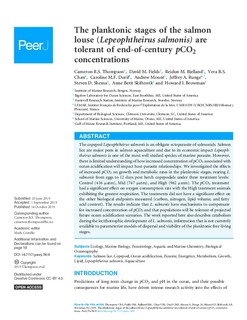The planktonic stages of the salmon louse (Lepeophtheirus salmonis) are tolerant of end-of-century pCO2 concentrations
| dc.contributor.author | Thompson, Cameron | |
| dc.contributor.author | Fields, David M. | |
| dc.contributor.author | Bjelland, Reidun Marie | |
| dc.contributor.author | Chan, Vera BS | |
| dc.contributor.author | Durif, Caroline | |
| dc.contributor.author | Mount, Andrew | |
| dc.contributor.author | Runge, Jeffrey A. | |
| dc.contributor.author | Shema, Steven | |
| dc.contributor.author | Skiftesvik, Anne Berit | |
| dc.contributor.author | Browman, Howard | |
| dc.date.accessioned | 2020-01-14T08:46:22Z | |
| dc.date.available | 2020-01-14T08:46:22Z | |
| dc.date.created | 2019-12-18T14:52:13Z | |
| dc.date.issued | 2019 | |
| dc.identifier.issn | 2167-8359 | |
| dc.identifier.uri | http://hdl.handle.net/11250/2636082 | |
| dc.description.abstract | The copepod Lepeophtheirus salmonis is an obligate ectoparasite of salmonids. Salmon lice are major pests in salmon aquaculture and due to its economic impact Lepeophtheirus salmonis is one of the most well studied species of marine parasite. However, there is limited understanding of how increased concentration of pCO2 associated with ocean acidification will impact host-parasite relationships. We investigated the effects of increased pCO2 on growth and metabolic rates in the planktonic stages, rearing L. salmonis from eggs to 12 days post hatch copepodids under three treatment levels: Control (416 µatm), Mid (747 µatm), and High (942 µatm). The pCO2 treatment had a significant effect on oxygen consumption rate with the High treatment animals exhibiting the greatest respiration. The treatments did not have a significant effect on the other biological endpoints measured (carbon, nitrogen, lipid volume, and fatty acid content). The results indicate that L. salmonis have mechanisms to compensate for increased concentration of pCO2 and that populations will be tolerant of projected future ocean acidification scenarios. The work reported here also describes catabolism during the lecithotrophic development of L. salmonis, information that is not currently available to parameterize models of dispersal and viability of the planktonic free-living stages. | nb_NO |
| dc.language.iso | eng | nb_NO |
| dc.title | The planktonic stages of the salmon louse (Lepeophtheirus salmonis) are tolerant of end-of-century pCO2 concentrations | nb_NO |
| dc.type | Journal article | nb_NO |
| dc.type | Peer reviewed | nb_NO |
| dc.description.version | publishedVersion | nb_NO |
| dc.source.pagenumber | 23. | nb_NO |
| dc.source.volume | 2019 | nb_NO |
| dc.source.journal | PeerJ | nb_NO |
| dc.source.issue | 10 | nb_NO |
| dc.identifier.doi | 10.7717/peerj.7810 | |
| dc.identifier.cristin | 1762624 | |
| dc.relation.project | Havforskningsinstituttet: 1459102 | nb_NO |
| dc.relation.project | Havforskningsinstituttet: 81529 | nb_NO |
| cristin.unitcode | 7431,17,0,0 | |
| cristin.unitcode | 7431,19,0,0 | |
| cristin.unitname | Sykdom og smittespredning | |
| cristin.unitname | Marin økosystemakustikk | |
| cristin.ispublished | true | |
| cristin.fulltext | original | |
| cristin.qualitycode | 1 |
Tilhørende fil(er)
Denne innførselen finnes i følgende samling(er)
-
Articles [3011]
-
Publikasjoner fra CRIStin [3061]
